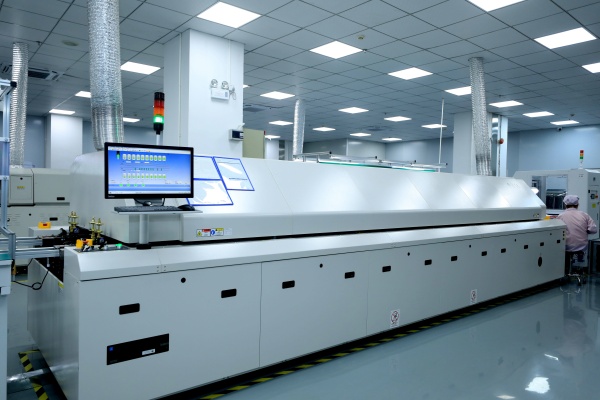What is wave soldering?
 28 Apr 2025 11:01:00 GMT
PCBASAIL
28 Apr 2025 11:01:00 GMT
PCBASAIL
Wave soldering is to use a wave soldering machine to directly contact the soldering surface of the plug-in board with high-temperature liquid tin to achieve soldering. When the component passes through the solder wave, the solder wave will heat the pin soldering area of the component, wet the soldering area and expand and fill it, and finally realize the soldering process. That is, a large number of DIP components are soldered on the PCB surface at the same time. The entire process goes through the board conveyor, preheating area, welding area, cooling area and control system. First, the printed circuit board to be soldered is placed on the board conveyor, and then the circuit board is heated in the preheating area to reach a suitable soldering temperature. Then, the circuit board enters the welding area, and the tin wave generated by the wave soldering machine is used to solder the lead end of the component or the welding end of the circuit board. Finally, the soldered circuit board is cooled and solidified in the cooling area to form a stable solder joint.

Why we use wave soldering technology?
1) High efficiency
The wave soldering equipment forms a "wave peak" through liquid solder, which can simultaneously solder all through-hole components on the circuit board at one time. Usually, the wave soldering equipment can process 300-1200 (pcs) of PCBs per hour, which is far more efficient than manual soldering, and is especially suitable for mass production needs such as automotive electronics and home appliance control boards.
2) Stable and high-quality welding quality
Wave soldering ensures that the solder fully fills the through-holes through dynamic pressure to form uniform solder joints, which can avoid problems such as inveracious soldering and missing soldering. When the board just enters the wave soldering equipment, the 100-150℃ preheating zone can reduce the thermal stress of the PCB and reduce the risk of warping or delamination. The most important thing is that our PCBASAIL wave soldering equipment meets the requirements of the international standard IPC-A-610 for welding morphology and strength.
3) Significant cost-effectiveness
In materials, the solder tank of the wave soldering machine can recycle tin-lead or lead-free tin, with a utilization rate of more than 90%, reducing waste. In labor costs, the automated process of wave soldering reduces the company's dependence on highly skilled welders and reduces manpower investment. Most of the wave soldering equipment on the market are currently equipped with automatic detection systems, such as solder level and temperature control, which is conducive to extending the equipment life cycle.
4) High flexibility
Wave soldering is highly compatible with through-hole components, such as traditional plug-in connectors, electrolytic capacitors, etc., and the soldering effect is better than reflow soldering. In modern wave soldering equipment, with integrated temperature sensors, flow controllers and data recording systems, some key parameters can be monitored in real time, such as solder temperature 245-265℃. This can ensure consistent process and quality.
5) Environmental protection
The use of closed wave soldering equipment is usually equipped with a smoke extraction system to reduce the risk of injury to operators. Not only that, our PCBASAI wave soldering equipment also supports lead-free solders of the RoHS directive, such as SAC305, following the concept of green environmental protection manufacturing.
How do we control the quality of PCB soldering?
Although wave soldering has great advantages over traditional manual soldering in the electronics manufacturing industry, we also need to pay attention to some issues in actual operation.
1) Equipment maintenance
PCBASAIL will regularly maintain the wave soldering machine, clean the oxide in the material tank every day, check the flatness of the nozzle every week to prevent the wave crest from deforming. It also calibrates the transmission chain speed in real time, with a typical value of 1.2-1.8, m/min, to ensure that the PCB is heated evenly. Although the wave soldering machine has automated and efficient production capabilities, if the equipment is not properly maintained, the quality of the PCB assembly will also decline, increasing the risk of rework and repair.
2) Control the quality of material
In the production workshop of PCBASAIL, the staff will strictly control the solder composition and regularly test the metal ratio of the solder tank (Sn/Gu content) to prevent Fe and Al from exceeding the standard and causing pollution. We also use antioxidants to reduce the generation of oxidized slag. For moisture-sensitive components, they are stored in a drying oven to prevent oxidation of the pads.
3) Accurate control of furnace temperature and welding parameters
The quality of wave soldering depends on the precise setting of various welding parameters. Usually the preheating temperature is set at 100-150℃, and the thermal shock is reduced by heating in stages, which helps to evaporate the flux, activate the activator, and prevent the PCB from being damp and bursting. The welding temperature and time are also precisely controlled. Too high a temperature may cause the pad to peel off, and too low a temperature may cause cold welding. Therefore, if lead-free solder SAC305 is used, the temperature is controlled at 245-265 ℃, and the contact time is set to 3-5 seconds.
4) PCB first piece debugging
Due to the diversity of PCB materials and components, some components have some unexpected problems during the furnace process. We usually do the first piece debugging first, and constantly adjust the PCB fixtures and wave soldering parameters and processes to ensure the welding performance.
In short, quality is the core of our work. PCBASAIL continuously improves the welding quality through the reasonable full-factor management of "manpower, machine, material, method, and environmental control", rich processing experience and technical means, to ensure that we can better serve our customers.



